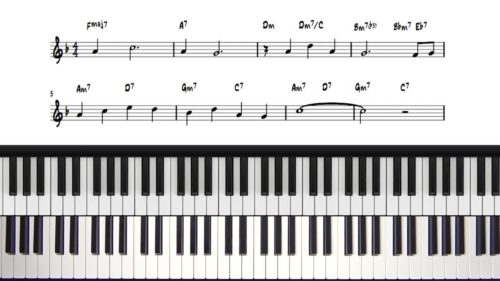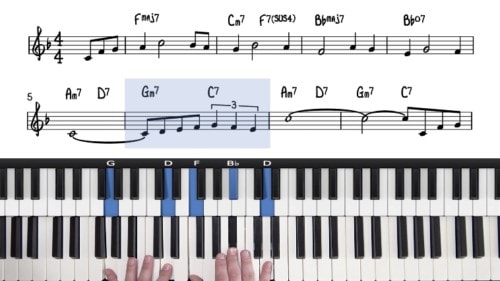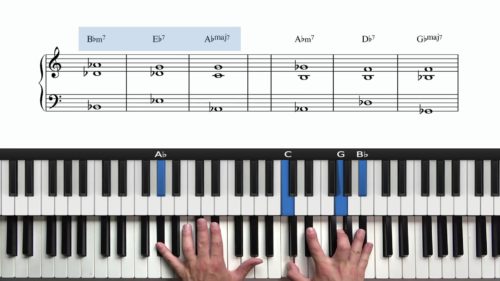How To Play 3-Note Spread Voicings
Welcome to lesson 2 in our course on cocktail jazz piano improvisation. In this lesson we are going to arrange the A section of the tune “Misty” with 3-note spread voicings.
In the previous lesson of this course we explored some diatonic voicing exercises in the key of Eb Major. We are now going to apply these voicings in context of the tune “Misty”.
What Are 3-Note Spread Voicings?
3-Note Spread voicings contain the root or tonic and the “essential chord tones” which are the 3rd and 7th degrees of the chord. Whilst these voicings can sound basic it’s important to be able to visualise these essential components of the harmony. In the next lessons we will introduce more sophisticated sounds with extended and altered harmony.
The quality of any chord (major, minor, or dominant) is defined by the 3rd and 7th and so harmonising a tune using 3-note spread voicings forces us to visualise the most essential components of the harmony.
The Form & Structure Of “Misty”
“Misty” follows an AABA form which means that the first 8 bars repeats 3 times within the 32 bar form. Due to this repetition it’s important that we understand the harmony of the A Section and also the voicing options available to us.
For the most part, we will voice the chords with the melody in our right hand pinky, the root with our left hand pinky, and the 3rd and 7th of the chord somewhere in between. This is the basic concept to build spread voicings.
Lesson Downloads
-
Spread Voicings Notation File Type: pdf
Practice Tips
-
Experiment by adding the 5th into your voicings to create a thicker sound than just the R-3-7 spread voicings composition. The 5th is an optional tone which adds more depth in the lower registers.
-
If you are new to jazz piano it may challenging to visualise the notes of the 7th chord split between 2 hands, but with practice this will become more natural and comfortable.
-
Pay special attention to the voice leading which is the 7ths falling to the 3rds in 25, 251, and 3625 progressions.
-
7ths falling to 3rds are also an important component of improvised melody lines which we will explore in the next module.






Brilliant course. Genuinely brilliant. Great primer in all the fundamentals in one spot. Love the expansion of the supporting materials.
Thanks you. Will be working through this one step by step this year.
So, so good. I have looked and sampled all over the internet for jazz piano lessons. Pianogroove is the best. Explanations are clear, paced well, scaffolded in manageable steps, easy to read layout, quick links to supporting lessons, harmony theory explained in a way that is easily grasped and immediately applied to a jazz standard along with practice drills. And the delicious icing is listening to your lovely voice. I purchased a single course but it’s looking like a subscription for me.
Hi Julie 👋
Thanks for the lovely comment and I’m glad that you are enjoying the lessons.
The is one of my latest courses so it’s great to hear your feedback. I’m moving more in this direction where I teach a whole course on the same tune and incorporate theory from other areas of the website.
You might also like the course on “The Nearness Of You” which follows a very similar structure: https://www.pianogroove.com/jazz-piano-lessons/ballad-voicings-fills-improv/
Enjoy the lessons and talk soon!
Cheers,
Hayden